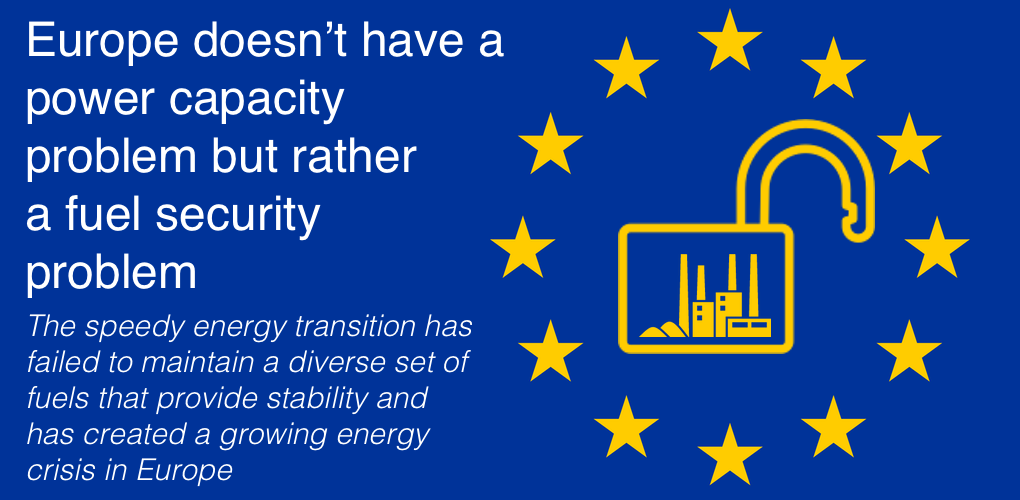
Europe’s Energy Crisis is all the Warning We Need
The past few weeks have seen Europe drift into an energy crisis of its own making – a perfect storm of bad policy. As wind generation has collapsed across Europe, overreliance on natural gas as a bridge fuel and backstop to renewable intermittency has come home to roost. Tight natural gas supplies, soaring prices and a recovering global economy hungry for energy have Europe on the verge of economic catastrophe – even well before winter when supply and price challenges typically peak.
The heart of the problem appears to be the speed of Europe’s energy transition and the failure to maintain a diverse set of fuels that provide stability. In other words, Europe doesn’t have a generating capacity problem but rather a fuel security problem.
As one analyst explained to Bloomberg, “The pace of decarbonization has taken everyone a bit by surprise but the challenge has been that the market structure that sits behind that hasn’t quite kept pace. The nature of energy security has changed so it’s no longer a question of how many gigawatts of capacity you have on the system, it’s whether they are able to supply power at the right time.” And for the past few weeks, all the eggs have been in the natural gas basket. The dismantling of dispatchable fuel diversity has left Europe woefully vulnerable to a volatile gas market and uncooperative weather.
Just a decade ago, the U.K. generated 40 percent of its power with coal. That capacity is now gone, the sacrificial lamb of chest-thumping climate ambition that has done almost nothing to lower global emissions but has left Britain alarmingly exposed to collapsing wind generation and out-of-control natural gas prices.
As Helen Thompson, a professor of political economy at the University of Cambridge, explained in a Financial Times op-ed, there’s simply no good alternative right now to natural gas in Europe even as import prices have jumped 440 percent in just a year.
“The absence of much wind in northern Europe this summer is consequential. In Britain, which enjoys the most propitious geographical conditions for wind power anywhere in Europe, nearly 60 per cent of electricity at times this month has come from gas.” She continues, “There are no solutions to this crisis, only politically nightmarish choices around hard realities… Energy consumption cannot be deferred until the future arrives. It can only occur at high prices or be rationed by the state.”
Energy intensive industries in Britain are shutting down. Consumers have already seen their electricity rates jump twice just this year, utilities are falling into bankruptcy and there’s well-founded concern there simply won’t be enough gas to go around this winter. This bleak scenario is playing out across much of the E.U.
Europe’s Soaring Energy Prices are Contagious
If Europe’s energy security and affordability crisis seems like something that can’t happen here, think again. American utilities and policymakers have warned about the pace of the energy transition, about growing fuel security problems and the loss of fuel diversity. Yet, Congress is weighing a plan to throw $150 billion at utilities to accelerate the transition and to further undo dispatchable fuel diversity with no plan to preserve grid reliability.
While U.S. natural gas prices haven’t reached the astronomical heights of those in Europe, they have doubled in just a year and could spike further this winter. And with 10 percent of U.S. natural gas production now flowing to exports, the U.S. market is increasingly influenced by what’s happening overseas. As The Wall Street Journal declared, “America’s Next Hot Import Might Be Record Energy Prices.”
U.S. natural gas prices have jumped above $5/MMBtu and could move far higher as the weather turns colder and demand spikes from both home and abroad. As the Journal observed, “the challenge in forecasting how high prices could rise lies in the unprecedented ties between the once isolated U.S. market and international prices…” Goldman Sachs has already warned that bitter cold could very well push natural gas prices to $10 or more, last seen at that level in 2008.
The painful reality is that the era of shale-driven cheap natural gas is coming to an abrupt end just as the U.S. has disassembled much of the dispatchable fuel diversity that has long-shielded consumers. In regions of the country where coal capacity remains, fuel switching is already helping alleviate pressure on wholesale electricity prices. But in other regions of the country now locked into overreliance on natural gas – such as New England, Florida or California – there’s no alternative to soaring prices.
Effectively managing the energy transition demands balancing decarbonization with maintaining affordability and reliability. Europe has already lost its balance and now faces an economy-wrecking energy crisis. While too many American policymakers are determined to follow the same disastrous path, there’s still time to pump the brakes and recognize the danger ahead. The warning from Europe couldn’t be clearer.
- On September 22, 2021
